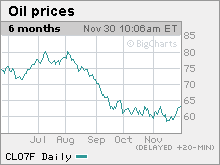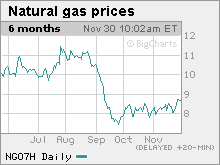U.S. escapes hurricane seasonEl Nino thwarts what experts had said would be an active year, but spate of strong storms still predicted for 2007 and beyond.NEW YORK (CNNMoney.com) -- Despite predictions for more storms than usual, the hurricane season of 2006 came to a close Thursday without a single hurricane making landfall in the continental United States. "It was really very fortunate," said National Oceanic and Atmospheric Administration (NOAA) spokeswoman Carmeyia Gillis. "With all the rebuilding still going on, a lot of people's blessings have been answered."
For the past three years multiple major hurricanes have made landfall in the Untied States, including 2005's Hurricane Katrina which devastated large swaths of the Gulf Coast and flooded New Orleans, resulting in the death of thousands. NOAA scientists attributed the surprisingly calm season this year to the rapid and unexpected formation of El Nino in the Pacific Ocean. El Nino is the warming of water in the Pacific, which in turn creates stronger winds in the Atlantic that blow apart hurricanes trying to form. Also helping keep major storms away from the U.S. this year was a large low pressure system sitting over the country that created strong winds out of he west, which pushed hurricanes eastward, out into the Atlantic. "We were extremely concerned," said Gerry Bell, NOAA's lead seasonal hurricane forecaster. "In the absence of El Nino, it would have been a very active season." Bell warned that just because the country got off easy in 2006, it doesn't mean it's the beginning of a trend. He said we are 12 years into an active hurricane cycle, which is caused by monsoon patterns in Africa and South America but is not fully understood. The active hurricane period can last anywhere from 25 to 40 years. "We can expect high hurricane landfalls for years to come" he said. "People should not get complacent." NOAA said the 2006 season had a total of nine named storms, five of which became hurricanes, two of them major ones. A normal hurricane season has 11 named storms, six of which become hurricanes, two of them major. Back in May leading hurricane scientists called for 17 named storms with nine hurricanes, five becoming major. The forecasts helped contribute to record oil prices and soaring natural gas prices over the summer. Crude hit a record of $78.40 in July, partially due to hurricane concerns. The Gulf accounts for one quarter of all U.S. domestic oil production and has the country's only deep water port for oil imports. Thursday's close of hurricane season had little impact on oil and gas prices, as the forward-looking markets had already bet on a weak hurricane season when El Nino was first observed back in September. Crude prices have fallen more than 20 percent since highs reached in July, while natural gas prices have fallen more than 25 percent. _________________ |
|



